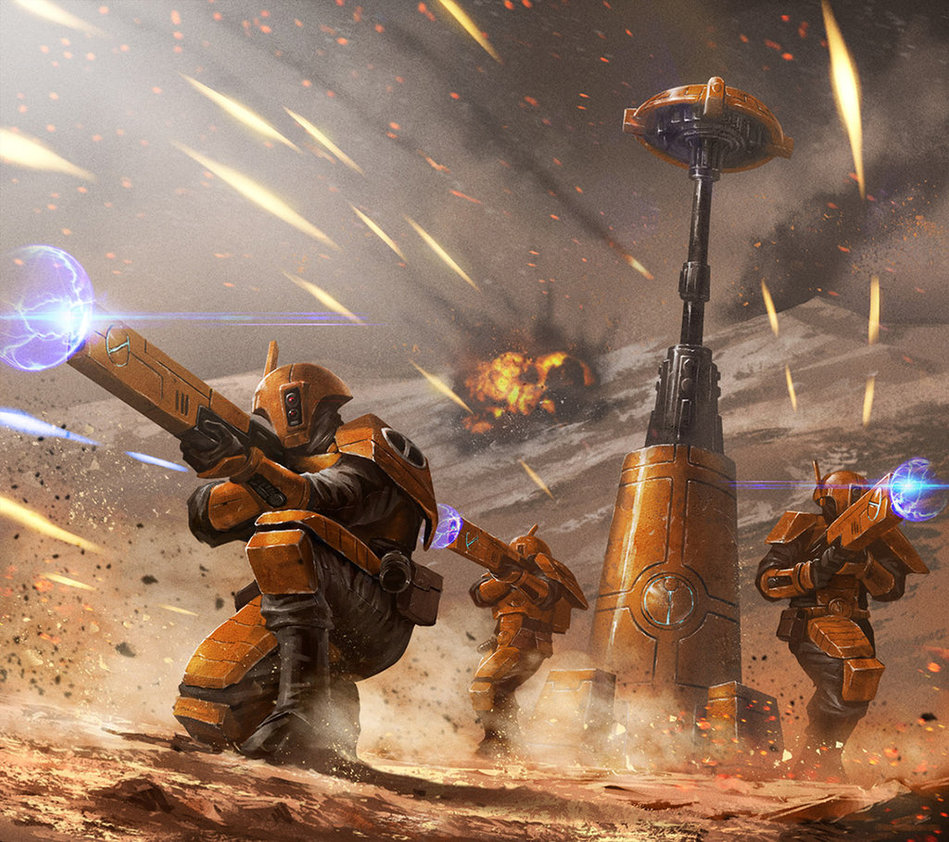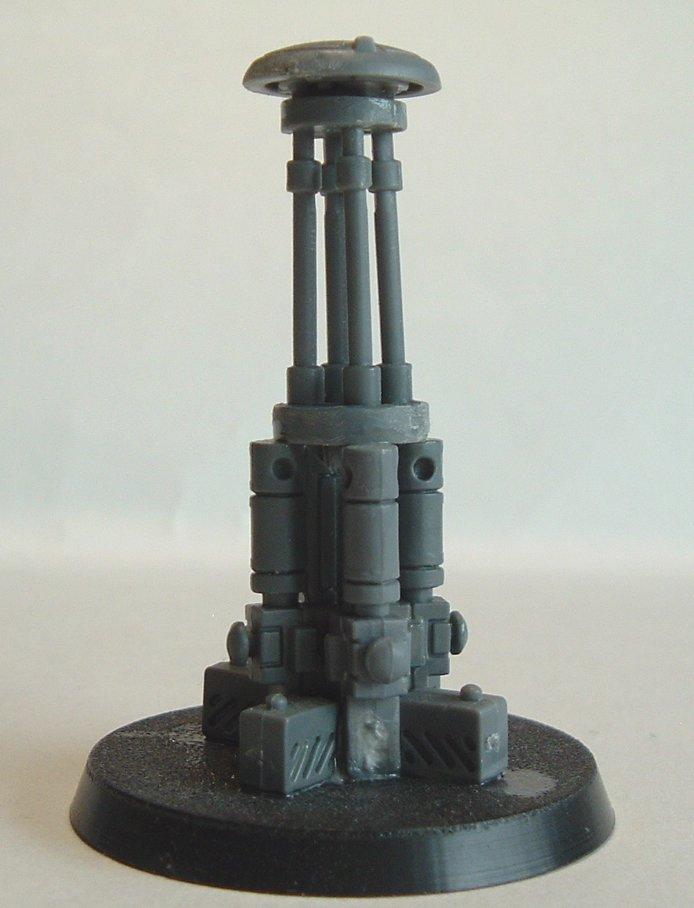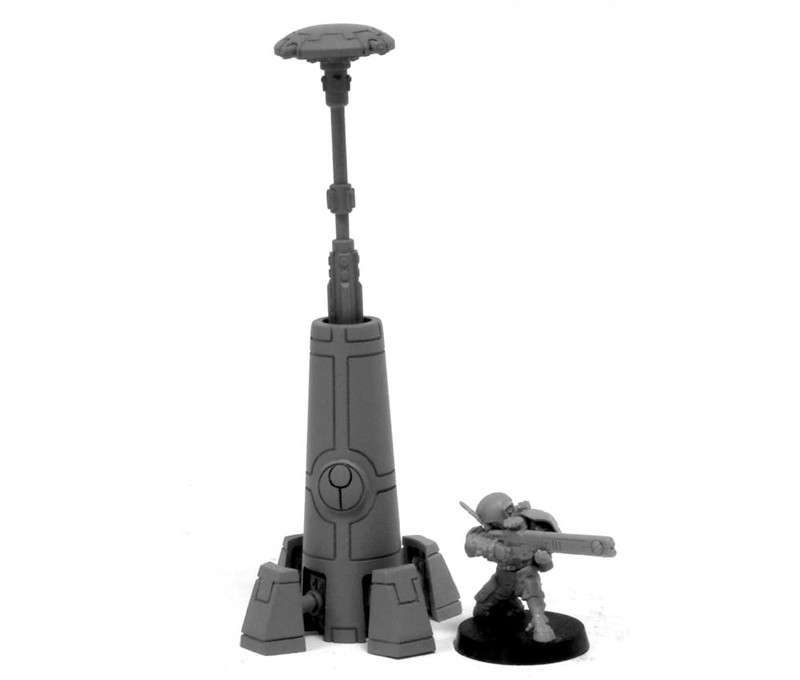It’s been a long journey, but we’ve finally made it- the final unit in the Tau codex review, the Remote Sensor Tower. What lies at the end of this road? Click to read on, or if you want to see the previous steps check out the Tactics Corner for more of the reviews and strategies from the book.
Overview
Remote Sensor Towers are the last in a line of very lackluster Tau fortifications, of which there have been quite a few in this series. For some reason, despite nominally eschewing fixed emplacements, Tau get more fortifications than any other army in the game and… yeah, none of them are good. Sensor Towers are arguably the best of the lot, but even that is not saying a lot- at the end of the day they are still fragile, awkward, immobile, and generally unimpressive.
Rules-wise, a Sensor Tower comes with a very bare-bones statline. Toughness six is pretty decent and means that smaller weapons will struggle to wound it, but with only three wounds and a 4+ save it will rarely be enough to last long- and heaven forbid that any “real” anti-vehicle weapons are directed at it. Ballistic Skill 4+ is actually a bit of a high point for a fortification, but with no other stats to even speak of we can’t be too impressed. At 40pts per model (and a limit of one model per slot), the Tower is pretty cheap but probably still not worth its price.
Special Rules and Wargear
So, a Remote Sensor Tower comes with two rules, both of them specific to its datasheet. Positional Relay is a bit of a strange one, as rather than affecting reserves or movement as one might expect it instead lets a single unit within 3″ of the Tower reroll 1s on shooting. This isn’t a terrible thing to have, but given how many other ways you can access rerolls, neither is it terribly impressive. The other rule, Immobile, is similar to the versions found on many other fortifications- it prevents the unit from moving and lets enemies hit it automatically in close combat. Unlike those other versions, however, a Tower cannot shoot while in combat (nor can you shoot into a combat involving it.)
For weapons, a Remote Sensor Tower comes with only a High-Intensity Markerlight (which is exactly like the normal version, but it adds three counters if you hit instead of one.) It has no options.
Uses
I’m not going to be quite as harsh on the Sensor Tower as I was on the Drone Sentry Turret, which we reviewed last week, but it carries virtually all of the same flaws as that unit. Being a wholly-immobile unit that can be locked in combat, the Tower is basically a wonderful little piece of bait for the enemy to hide up against on your turn- simply wandering within 1″ of it allows a unit to be completely protected from your shooting, with nothing you can do about it. And sure, you can use For the Greater Good to try and support the tower and prevent this, but only if you keep units clustered around this, and given the static nature of the piece this isn’t exactly an ideal solution.
So yeah, you’re probably not going to ever bring a Sensor Tower because they represent a crippling vulnerability in a Tau list, namely a unit that is extra-easy to lock in combat. However, even outside of that context they are… not great. Each Tower occupies an entire fortification slot by itself, meaning you’re never going to bring very many of them- and in terms of being a source of Markerlights, they aren’t particularly efficient. 40pts gets you an average of 1.5 hits per turn, but for 40pts you could also be getting five Pathfinders (2.5 average hits per turn, scout move) or four Marker Drones (2 hits per turn, fully mobile and savior protocols.) Of course, there’s also the automatic reroll that you can factor in as being a thing, which is useful for starting Markerlight chains, but the very spikey nature of the High Intensity Markerlight means it’s actually significantly less useful than three regular ones would be (and all the more so because it can’t be used in combination with the Uplinked Markerlight strat.)
The required detachment in order to take it is also a significant downside, as it limits your other detachments available, which are always in great demand as Tau. Armies typically want three detachments in order to maximize their command points (e.g. triple battalion), to bring along specialist septs to do unique jobs (e.g. Sa’cea for Marksmen, Bor’kan for Y’varhas, Farsight for Fusion Blades, etc), or to bring the full three Commanders to the game. An army that includes a fortification network detachment loses out in all these regards and is basically playing down by a significant amount before the game even begins; if the Sensor Tower were an exceptionally-efficient way to bring Markerlight support this might be acceptable (although it seems unlikely that it would be able to compete with Sa’cea in this respect), but with its efficiency being worse than your other options in that regard there is virtually no excuse for including one except as a weird joke.
Countering
Play a game of Warhammer 40,000 and score more points than your opponent. It shouldn’t be hard when they are handicapping themselves with this unit.
Final Thoughts
Most Forge World units these days are regarded as being comically bad (with a handful of rare exceptions), and it’s not hard to see why. Although I understand GW’s erring on the side of caution after what had happened during 7E, and especially because the Forge World units were all designed back in the Index phase of the game when armies were significantly weaker as a whole and most units had higher point costs, I think that even from that perspective there are a lot of very strange choices being made in the Imperial Armor Indices that don’t make any kind of obvious sense to an outside observer. That said, it’s not impossible that they will eventually be fixed once “real” releases start to be made for Forge World… although I wouldn’t hold my breath waiting for this to happen.
As always, remember that you can get your wargaming supplies at great discounts every day from the Frontline Gaming store, whether you’re looking to start a new army or expand an existing one.






Does that mean nobody is writing up an article on The Eight? Having been playing them for a couple of months I’d say they are more viable in competitive play than most of the FW stuff and are provably up to the job of winning RTTs at least.
Maybe I should just see if Reece wants me to write one 🙂
I don’t have any plans on doing it 🙂
I mean, I suppose I could, but it really does just boil down to “they’re bad, don’t take them.” I only went through the last of the FW units here out of completeness’ sake, as there’s not really a lot to say about most of them and I kinda feel The Eight are in the same position.
The only one of The Eight that is really of any interest is Ob’lotai, since he is a character-protected Broadside, but even that isn’t really all that special given the existence of Savior Protocols already; the rest of the commanders available are just badly-equipped from the get go and mostly carry extremely uninteresting loadouts (or even outright-terrible ones, looking at you Shavastos) and you gain very little for it given the points invested- you get more firepower out of three “correctly” equipped Commanders than you do out of the six Commanders available to you via the formation, to say nothing of the points investment.
Basically, it’s super-bad and there’s no reason to even look at taking it, apart from purely narrative games.
Until you put The Eight on the table in a competitive game I guess that would be a common opinion. If that is a common opinion then it is all the more reason to have an article on it – because that is not how it plays out on the table at all.
To be fair when I built my Eight that is more or less what I thought they were on paper – I built them to be my fun fluffy army for casual and narrative games. After my first couple of games with them I realised my mistake and switched them over to be my tournament list in place of my more conventional T’au Sept force. The last two RTTs have been the easiest tournament wins I have ever had.
I still do not think that they are the best possible T’au list but dismissing them as super-bad is just plain wrong.
*shrug* I mean, if it’s working for you then more power to you, but I think the downsides are pretty obvious even on the most basic level (points cost, firepower), to say nothing of stuff like the CP you’re paying, weak detachment benefit, etc.
Feel free to write an article on them if you want to, I certainly won’t stop you. But I don’t think I’m alone in dismissing them as a “real” choice from the codex, and I feel that decision is pretty justified. Winning RTTs means essentially nothing- I’ve won RTTs with my Assassins list, which is itself quite bad. Now, if you take that thing to a GT and start posing wins against the armies you see there after three rounds… maybe we’ll have this discussion again with a very different framing.